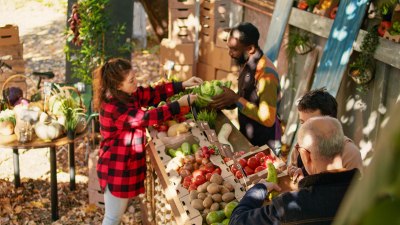How Farmers’ Markets Reflect the Changing Seasons in Surprising Ways
Explore how farmers' markets showcase seasonal produce and community engagement, adapting uniquely throughout the year.

Farmers' markets serve as vibrant community hubs, reflecting the natural cycle of the seasons in ways that resonate with local culture and sustainable practices. These markets, often set up in urban and rural areas alike, allow farmers and artisans to sell their fresh produce, homemade products, and unique crafts directly to consumers. As seasons shift, so do the offerings at these markets, creating a dynamic experience for shoppers and vendors alike.
The Spring Awakening
Spring is a time of renewal, and farmers' markets reflect this vitality through a diverse array of products. As the earth thaws and days grow longer, early spring crops begin to sprout. Asparagus, peas, and radishes are among the first to appear, bringing bright colors and fresh flavors to market stalls. Additionally, the arrival of local herbs such as cilantro, basil, and mint marks a turning point, as both vendors and shoppers eagerly anticipate the gardening season ahead. The presence of seedlings and young plants for sale at these markets is a clear indicator of community engagement in gardening, which tends to flourish during this season.
Summer Abundance
As summer settles in, farmers’ markets transform into a cornucopia of produce. This season is characterized by an abundance of fruits and vegetables, including tomatoes, zucchini, corn, berries, and peaches. Shoppers visit markets with baskets in hand, eager to stock up on the flavors of summer. Vendors often showcase their best-sellers alongside some lesser-known varieties, encouraging consumers to explore new tastes. Exotic offerings like heirloom tomatoes or specialty peppers make their appearances, contributing to a colorful display that reflects the vibrancy of summer. Cooking demonstrations and educational workshops often pop up, promoting a farm-to-table lifestyle while highlighting seasonal cooking strategies.
Autumn Harvest
As the days begin to shorten and temperatures drop, autumn signifies a time of harvest. Farmers' markets take on a slightly different character; vendors display not just fresh produce but also preserved goods such as jams, pickles, and baked goods. Pumpkins, squash, and apples dominate the scene, attracting families eager to prepare for fall festivities. Events like apple cider tastings or pumpkin carving contests often coincide with the market's offerings, fostering a sense of community and celebration of the harvest. This season also prompts vendors to share their knowledge about canning and preserving, helping consumers extend that seasonal bounty into the winter months.
Winter Wonders
Even in the cold of winter, farmers' markets can host a variety of unique experiences. While fresh produce may become sparse, the market showcases winter crops such as root vegetables, kale, and hearty greens. Many farmers utilize greenhouse techniques or hoop houses to extend their growing season, offering fresh greens and vegetables even in the harshest conditions. Additionally, local artisans often feature handmade crafts, seasonal gifts, and gourmet food items—great for holiday shopping. The atmosphere at winter markets can bring a festive spirit, especially with holiday-themed events, lighting, and live music, providing an inviting contrast to the cold outside.
The Role of Community
Beyond their agricultural significance, farmers' markets play a critical role in building community connections. They provide an opportunity for local residents to gather, fostering relationships between consumers and producers. This direct interaction encourages a greater appreciation for the labor and care that goes into food production and promotes local economies. Many markets also include cooperative events where local artisans can showcase their crafts, creating a platform for small businesses to thrive. Educational programs can also take place, from nutrition workshops to cooking classes, enhancing community engagement and promoting healthier lifestyles.
Adapting Through Challenges
Despite facing various challenges, farmers' markets have shown incredible adaptability. Whether responding to climate change or shifting consumer preferences, these markets continuously evolve. In recent years, many have incorporated online ordering systems and community-supported agriculture (CSA) models, enabling customers to reserve their favorite items ahead of time or participate in subscription-based delivery. This adaptability not only keeps customers engaged but also helps local farmers find new markets for their products. Community initiatives that focus on inclusivity and accessibility further emphasize the role of these markets in fostering social equity.
Global Influence
The trends observed in local farmers' markets reflect larger movements within the global agricultural landscape. The awareness around organic products, sustainable farming practices, and food sovereignty continues to shape consumer preferences. Farmers' markets become a point of convergence where these ideas take root, allowing communities to promote the importance of supporting local agriculture while addressing global concerns about food security and climate change. This global influence often lends itself to various cultural exchanges, where diverse foods and traditions can be celebrated through the market’s offerings.
Farmers' markets are more than just venues for selling produce—they are vibrant manifestations of community spirit, seasonal rhythms, and sustainable practices. As the seasons change, so do the products offered, reflecting not only the bounty of local farms but also the resilient character of the communities they serve. In a world increasingly dominated by industrial agriculture and global food chains, farmers' markets offer a refreshing reminder of the importance of local connections and seasonal eating. Whether you are a seasoned market-goer or a curious newcomer, visiting these markets provides an opportunity to engage with your community and experience the ever-changing landscape of food production.











